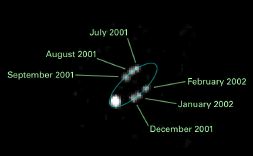

,
|
Документ взят из кэша поисковой машины. Адрес
оригинального документа
: http://www.stsci.edu/~inr/thisweek1/2008/thisweek231.html
Дата изменения: Mon Aug 18 21:43:09 2008 Дата индексирования: Sat Sep 6 06:50:54 2008 Кодировка: Поисковые слова: п п п п п п п п п п п п р п р п р п р п р п р п р п р п р п р п р п п р п п р п |


,
| Program Number | Principal Investigator | Program Title | Links |
| 10872 | Harry Teplitz, California Institute of Technology | Lyman Continuum Emission in Galaxies at z=1.2 | Abstract |
| 11072 | Carole A. Haswell, Open University | Measuring the Physical Properties of the first two WASP transiting extrasolar planets | Abstract |
| 11101 | Gabriela Canalizo, University of California - Riverside | The Relevance of Mergers for Fueling AGNs: Answers from QSO Host Galaxies | Abstract |
| 11113 | Keith S. Noll, Space Telescope Science Institute | Binaries in the Kuiper Belt: Probes of Solar System Formation and Evolution | Abstract |
| 11130 | Luis Ho, Carnegie Institution of Washington | AGNs with Intermediate-mass Black Holes: Testing the Black Hole-Bulge Paradigm, Part II | Abstract |
| 11136 | Michael C. Liu, University of Hawaii | Resolving Ultracool Astrophysics with Brown Dwarf Binaries | Abstract |
| 11156 | Kathy Rages, SETI Institute | Monitoring Active Atmospheres on Uranus and Neptune | Abstract |
| 11157 | Joseph H. Rhee, University of California - Los Angeles | NICMOS Imaging Survey of Dusty Debris Around Nearby Stars Across the Stellar Mass Spectrum | Abstract |
| 11172 | Arlin Crotts, Columbia University in the City of New York | Defining Classes of Long Period Variable Stars in M31 | Abstract |
| 11178 | William M. Grundy, Lowell Observatory | Probing Solar System History with Orbits, Masses, and Colors of Transneptunian Binaries | Abstract |
| 11192 | Hao-Jing Yan, Observatories of the Carnegie Institution of Washington | NICMOS Confirmation of Candidates of the Most Luminous Galaxies at z > 7 | Abstract |
| 11203 | Kevin Luhman, The Pennsylvania State University | A Search for Circumstellar Disks and Planetary-Mass Companions around Brown Dwarfs in Taurus | Abstract |
| 11205 | James Muzerolle , university of Arizona | The Effects of Multiplicity on the Evolution of Young Stellar Objects: A NICMOS Imaging Study | Abstract |
| 11211 | George Fritz Benedict, University of Texas at Austin | An Astrometric Calibration of Population II Distance Indicators | Abstract |
| 11218 | Howard E. Bond, Space Telescope Science Institute | Snapshot Survey for Planetary Nebulae in Globular Clusters of the Local Group | Abstract |
| 11221 | Julianne Dalcanton, University of Washington | A Dark Core in Abell 520 | Abstract |
| 11235 | Jason A. Surace, California Institute of Technology | HST NICMOS Survey of the Nuclear Regions of Luminous Infrared Galaxies in the Local Universe | Abstract |
| 11237 | Lutz Wisotzki, Astrophysikalisches Institut Potsdam | The origin of the break in the AGN luminosity function | Abstract |
| 11512 | Mark Raboin Swain, Jet Propulsion Laboratory | Molecules in Exoplanet Atmospheres | Abstract |
| 11544 | Adam L. Kraus, California Institute of Technology | The Dynamical Legacy of Star Formation | Abstract |
| 11545 | Ben Davies, Rochester Institute of Technology | A NICMOS survey of newly-discovered young massive clusters | Abstract |
| 11548 | S. Thomas Megeath, University of Toledo | NICMOS Imaging of Protostars in the Orion A Cloud: The Role of Environment in Star Formation | Abstract |
GO 11113: Binaries in the Kuiper Belt: Probes of Solar System Formation and Evolution
 A composite of HST images of the Kuiper Belt binary, WW31
A composite of HST images of the Kuiper Belt binary, WW31
|
The Kuiper Belt consists of icy planetoids that orbit the Sun within a broad band stretching from Neptune's orbit (~30 AU) to distance sof ~50 AU from the Sun (see David Jewitt's Kuiper Belt page for details). Over 500 KBOs are currently known out of a population of perhaps 70,000 objects with diameters exceeding 100 km. Approximately 2% of the known KBOs are binary (including Pluto, one of the largest known KBOs, regardless of whether one considers it a planet or not). This is a surprisingly high fraction, given the difficulties involved in forming such systems and the relative ease with which they can be disrupted. It remains unclear whether these systems formed from single KBOs (through collisions or 3-body interactions) as the Kuiper Belt and the Solar System have evolved, or whether they represent the final tail of an initial (much larger) population of primordial binaries. This proposal will use WFPC2 imaging of known KBOs to identify new binary systems. |
GO 11157: NICMOS Imaging Survey of Dusty Debris Around Nearby Stars Across the Stellar Mass Spectrum
GO 11192: NICMOS Confirmation of Candidates of the Most Luminous Galaxies at z > 7 231
GO 11544: The Dynamical Legacy of Star Formation